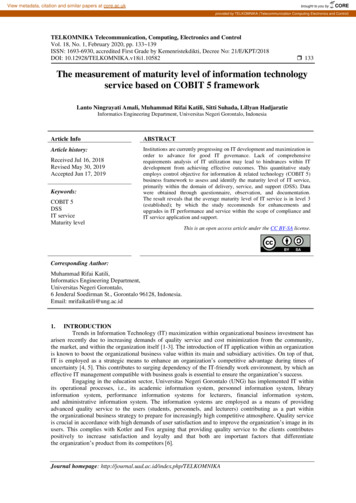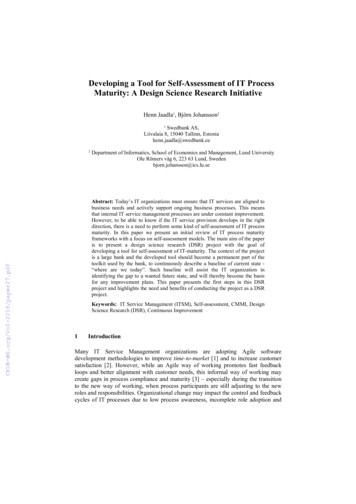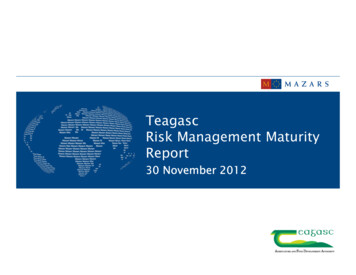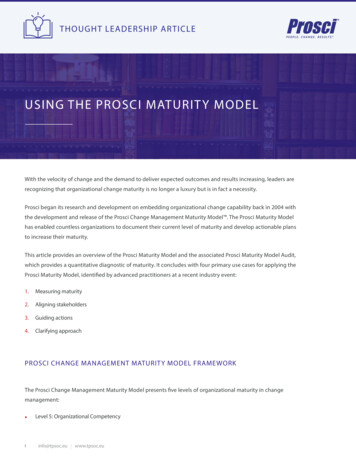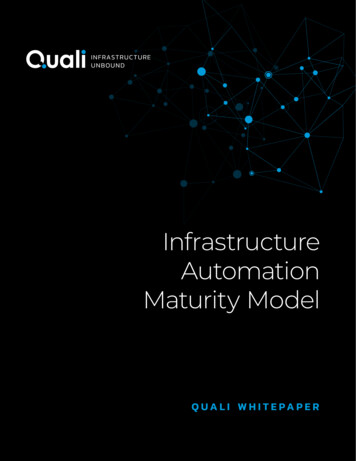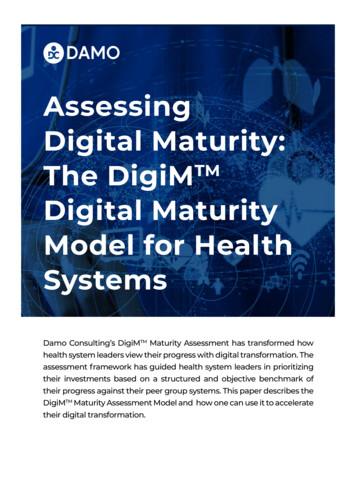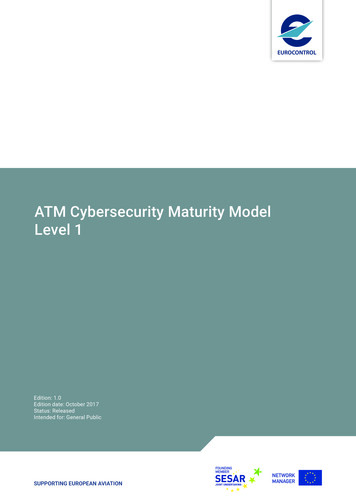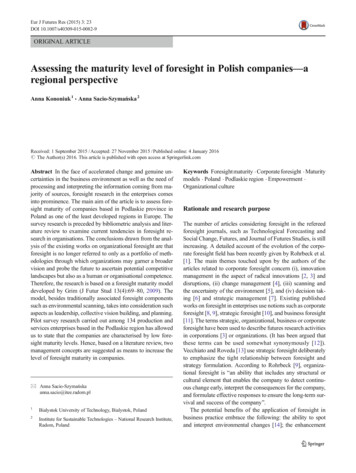
Transcription
Eur J Futures Res (2015) 3: 23DOI 10.1007/s40309-015-0082-9ORIGINAL ARTICLEAssessing the maturity level of foresight in Polish companies—aregional perspectiveAnna Kononiuk 1 & Anna Sacio-Szymańska 2Received: 1 September 2015 / Accepted: 27 November 2015 / Published online: 4 January 2016# The Author(s) 2016. This article is published with open access at Springerlink.comAbstract In the face of accelerated change and genuine uncertainties in the business environment as well as the need ofprocessing and interpreting the information coming from majority of sources, foresight research in the enterprises comesinto prominence. The main aim of the article is to assess foresight maturity of companies based in Podlaskie province inPoland as one of the least developed regions in Europe. Thesurvey research is preceded by bibliometric analysis and literature review to examine current tendencies in foresight research in organisations. The conclusions drawn from the analysis of the existing works on organizational foresight are thatforesight is no longer referred to only as a portfolio of methodologies through which organizations may garner a broadervision and probe the future to ascertain potential competitivelandscapes but also as a human or organisational competence.Therefore, the research is based on a foresight maturity modeldeveloped by Grim (J Futur Stud 13(4):69–80, 2009). Themodel, besides traditionally associated foresight componentssuch as environmental scanning, takes into consideration suchaspects as leadership, collective vision building, and planning.Pilot survey research carried out among 134 production andservices enterprises based in the Podlaskie region has allowedus to state that the companies are characterised by low foresight maturity levels. Hence, based on a literature review, twomanagement concepts are suggested as means to increase thelevel of foresight maturity in companies.* Anna Sacio-Szymańskaanna.sacio@itee.radom.pl1Bialystok University of Technology, Bialystok, Poland2Institute for Sustainable Technologies – National Research Institute,Radom, PolandKeywords Foresight maturity . Corporate foresight . Maturitymodels . Poland . Podlaskie region . Empowerment .Organizational cultureRationale and research purposeThe number of articles considering foresight in the refereedforesight journals, such as Technological Forecasting andSocial Change, Futures, and Journal of Futures Studies, is stillincreasing. A detailed account of the evolution of the corporate foresight field has been recently given by Rohrbeck et al.[1]. The main themes touched upon by the authors of thearticles related to corporate foresight concern (i), innovationmanagement in the aspect of radical innovations [2, 3] anddisruptions, (ii) change management [4], (iii) scanning andthe uncertainty of the environment [5], and (iv) decision taking [6] and strategic management [7]. Existing publishedworks on foresight in enterprises use notions such as corporateforesight [8, 9], strategic foresight [10], and business foresight[11]. The terms strategic, organizational, business or corporateforesight have been used to describe futures research activitiesin corporations [3] or organizations. (It has been argued thatthese terms can be used somewhat synonymously [12]).Vecchiato and Roveda [13] use strategic foresight deliberatelyto emphasize the tight relationship between foresight andstrategy formulation. According to Rohrbeck [9], organizational foresight is Ban ability that includes any structural orcultural element that enables the company to detect continuous change early, interpret the consequences for the company,and formulate effective responses to ensure the long-term survival and success of the company .The potential benefits of the application of foresight inbusiness practice embrace the following: the ability to spotand interpret environmental changes [14]; the enhancement
23 Page 2 of 13of strategic planning processes [15]; and, the increase of innovative capabilities [16]. The confirmation of the benefits mentioned above is in the empirical research carried out byRohrbeck and Schwartz [17] in 77 enterprises. The authors,basing their research on organizational models describing theenterprise as an interpretative system [18], prove that the formalized process of foresight increases the ability of thefollowing:–––––Unprecedented events and trends detection,Changes interpretation,Reaction to changes,Organizational learning, andInfluencing the decision of co-working entities.In the context of the three major steps of the foresightprocess, consisting of (1) the collection of information, (2)interpretation, and (3) utilization, a company would need relevant skills to find, filter, interpret, and use future relevant datain managerial practice and would require the access to relevantsources of information about possible futures. This understanding is echoed by Lichtenthaler [19] stating that the effectiveness of technology management is fundamentally influenced by the quality of a firm’s technology intelligence process, i.e., the acquisition and assessment of information ontechnological trends.More specifically, according to Rohrbeck et al. [20], fivefactors can be listed that have an impact on the success offoresight. These are the following:–––––Information usage, which comprises information sourcesand information gathering methods;Method sophistication, how methods are chosen andused;People and networks, qualities of foresight staff;Organisation of foresight activities within companies;and,Culture; how supportive is the corporate culture towardsforesight activities?Having been motivated to use foresight to aid the strategicmanagement process, companies may follow one or combinetwo of the following organisational approaches [21]:1) A company might introduce foresight processes internallyand/or2) A company might internally use the results from foresightactivities performed by other actors.The main benefit of the first approach is that it is tailormade to the objectives of a single company in terms of foresight outcomes achieved and it provides additional valuestemming from the foresight process, which, if set up on aEur J Futures Res (2015) 3: 23continuous basis, may itself become another key competenceand advantage of a company. The main disadvantages couldbe associated with greater resources (human, financial) to becommitted. Also depending on internal competences, this option might require assistance from external facilitators or advisors (private foresight consultancies).The second approach includes using data (e.g., surveys,Delphi results) from national, regional, or sectoral foresightactivities for business and especially for strategic planningpurposes. Since the data is more general in nature, companiesmust adapt them to their different uses and purposes in orderto achieve the desired impact. A critical issue related to thissecond approach is making sure that the foresight results usedby a company, the so-called Bone-fits-all information package, meet futures quality standards criteria [22, 23]. In addition, avaluable tool to evaluate the relevance of information aboutpossible futures could be the Futures Map [24], which is defined as Bthe comprehensive description of the outcomes offutures research process. It provides validity criteria (internaland external ones), which make it possible (1) to evaluate thequality of the process that produces the map and (2) to assessthe information content of the map and the usefulness of thecontent to the customers of the map.Considering the above, many projects have been set up bynational and local governments with the aim to disseminateforesight methodology and build a foresight culture amongcompanies. The examples include the following:–––UK Foresight Training Toolkit [25] (a set of workshopsand training materials offered to SMEs) and applied inScotland, Northern Ireland and the West Midlands,1Finnish Uusimaa Employment and EconomicDevelopment Centre (EEDC2) project [27],Danish Technology and Enterprise in the Future projectcarried out in co-operation with the Confederation ofDanish Industries (Dansk Industri) and the CentralOrganisation of Industrial Employees in Denmark (COIndustri) [28].Similar projects addressed to companies are also run byprivate consultancies or non-profit organizations. They usually aim at helping enterprises define their strategy, assess acompany’s strengths and weaknesses, make use of opportunities, and avoid threats by advising them to find and interprettrends that are applicable for their line of business. Examples1Over 3000 SMEs were advised over the 2 years of the programme's firstphase, in 200 of them, in-company foresight exercises were conducted.([26], pp. 21–22)2The results of the project were used in the planning of further trainingfor employees and in the planning of supporting activities for SMEs. Twofollow-up projects were started for the support and development of enterprises, one for start-up businesses, and the other for fast-growing businesses. ([27], p. 190–197).
Eur J Futures Res (2015) 3: 23Page 3 of 13 23of such initiatives include the initiative undertaken bySYNTENS [29], a Dutch non-profit organization, which developed a set of tools and methods (called ToekomstWijzer)that aimed to encourage and help SMEs ‘look’ into the futureand make business strategies and new policy choices based onexternal trends and signals.Finally, the following are some examples of national foresight projects/studies,3 the results of which could be used on acorporate level:agreed to take part in the study. The selection of the researchedcompanies was based on convenience sampling, which is anon-probability sampling technique where subjects are selected because of their convenient accessibility and proximity tothe researcher.The following four research questions were used to guidethe research:–––––The well-grounded Japanese foresight programme [31],The German BMBF foresight process 2007–2009 [32],andThe study of the radical technologies of the futurecommissioned by the Parliament of Finland’sCommittee for the Future in 2013 [33].Specifically, the methodological approach developed andimplemented in Finland (named Radical Technology Inquirer)seems to appropriately address the needs of companies, sinceit lists the 100 most promising Radical TechnologicalSolutions (RTS) in the context of the 20 Global ValueProducing Networks (GVPN). A company might take theRTS from the reference list and evaluate technologies of itstechnology portfolio in the frame defined by the GVPNs todecide whether they are worth investing in [33].Based on the presented conclusions and preliminary work,the rationales for this research are as follows:–––––An increase in popularity as well as the confirmed effectiveness of foresight research conducted in or for companies which have been reported in key futures researchjournals;The documented beneficial influence of foresight research conducted in companies on skills improvementin the area of creating product, process and service innovations by companies, both incremental and radical;Support in the process of building a consistent reconfiguration of companies’ strategic resources, which determine their competitive advantage;The opportunity of filling the gap in assessing foresightmaturity in companies based in an under-developed region in Europe; and,The lack of research on foresight activities in Polishcompanies.The main research purpose was to assess foresight maturityof companies based in Podlaskie province in Poland as one ofthe least developed regions in Europe. The pilot study wascarried out in 2014. One hundred thirty-four enterprises3More information about national foresight processes implemented invarious countries is given in [30].––What are the current tendencies of corporate foresightresearch?How does one assess foresight maturity of companies?What is the foresight maturity of companies based in thePodlaskie region in Poland?What management practices could be used to improve theforesight maturity of companies based in less developedregions?The research process comprised six research stages.In the first stage, a bibliometric analysis based on theSCOPUS database is carried out. Secondly a literature reviewon foresight in enterprises follows using EBSCO, ElsevierScience Direct, Springer and Emerald databases. In the thirdstage, the foresight maturity model FMM [34] is presented.The fourth stage introduces the characteristics of the Podlaskieregion based on statistical data. The fifth stage is devoted tosurvey research with the aims of (1) determining the prevalence of foresight research in the Podlaskie region and (2)evaluating the foresight maturity level of manufacturing andservice enterprises in the Podlaskie region. The final stage ofthe research is devoted to developing recommendations forfurther research.Bibliometric analysisThe literature review was preceded by a bibliometric analysisbased on the SCOPUS database, which enabled the authors ofthe article to indicate the tendencies in the field of strategicforesight research. The selection of the following databasewas determined by its availability. The authors collected articles from the period 1987–2015. For the purpose of the research, the authors created a database containing 379 scientificarticles, 93 conference papers, 56 reviews, 17 book chapters,and 14 articles in press containing the phrase Bstrategicforesight. The majority of the articles came from leadingforesight journals, such as Technological Forecasting andSocial Change (75 articles), Foresight (59 articles), Futures(43 articles), Technology Analysis and Strategic Management(14 Articles), Futuribles Analyse Et Prospective (13 articles),and Journal of Futures Studies (13 articles).For the purpose of the bibliometric analysis, the authors of the article applied VOS, which is a mappingtechnique that can serve as an alternative to the well-
23 Page 4 of 13known technique of multidimensional scaling (MDS).VOS stands for visualization of similarities and has beenused for constructing bibliometric maps in a number ofstudies [35–40].The analysis was supported by VoSViewer software[35]. The authors carried out a co-word analysis in relation to titles, abstracts, keywords, and index words fromthe researched period of time and applying a methodologyby Dobrzynski, Dziekonski, and Jurczuk [41]. The abovementioned set of data was the subject to a two-stage preliminary analysis—the automatic exclusion of selectedEnglish words such as prepositions and articles as wellas the exclusion of words was carried out by the authorsof the article on the basis of their expertise in the field offoresight research. Words such as author, aim, and result,to name but a few, and other extraneous terms were excluded. In the first phase of the preliminary analysis, of12,859 terms, 330 met the threshold of 10, which was theminimum number of occurrences of a term. In the secondphase, 272 terms were left (58 words were excluded bythe authors of the article). The results of the analysis arepresented in Fig. 1.The colour of a point on the map is close to the colourof a certain cluster if there are a large number of itemsbelonging to that cluster in the neighbourhood of thepoint. The larger the number of items in theneighbourhood of a point, the closer the colour of thepoint is to red. Conversely, the smaller the number ofitems in the neighbourhood of a point, the closer the colour of the point is to blue. The size of a circle reflects anEur J Futures Res (2015) 3: 23item’s total number of co-occurrences [39]. Based on thedata presented in the Fig. 1, some tendencies might beobserved. First of all, one can identify three main clustersof terms’ co-occurrences. The first one is located aroundthe word implication, which co-occurs most frequentlywith such words as technology foresight, economy instrument, foresight study, and society. The authors presumethat the terms may originate from articles focusing onthe description of experiences with technology foresightapplications for the enhancement of various sectors, regions, countries, etc. The words located around the termstrategic foresight form the greatest cluster. As can beseen, the term itself co-occurs most frequently with theterms such as company, market, product, person, andability. The qualitative analysis of the articles from theleading journals presented in the next section of this article confirms that foresight is no longer referred to only asa portfolio of methodologies through which an organization may garner a broader vision of the future to ascertainpotential competitive landscapes [10, 16], but rather anability that includes any structural or cultural elementthat enables the company to detect continuous changeearly, interpret the consequences for the company andformulate effective responses to ensure the long term survival and success of the company [9]. The third cluster isformed around the word manager that co-occurs withterms such as organization and theory. The authors of thisarticle assume that these terms may originate from thearticles aiming at advancing the theory of management,but further qualitative analysis is needed in this respect.Fig. 1 A co-word analysis of the term strategic foresight density visualization carried out based on the articles from the 1987–2015 period (Source:Authors)
Eur J Futures Res (2015) 3: 23Literature review on the links between foresight,strategy, and organizational cultureIn the literature, foresight is often portrayed as a technicaland analytic process [42], where the focus is put more onmethods, methodologies, or systems developed and applied in various contexts (national, regional, sectorial,organisational) depending on the context of a specificforesight exercise. This approach can be justified regarding foresight executed on macro levels, where the mainaims of foresight exercises focus rather on the foresightoutcomes and not the foresight process itself as it usuallytakes place when organisational foresight is considered.It is in business environments where the role of individuals is pivotal to the building of a company’s competitive advantage based on foresight as one of its corecompetences. As underlined by Vechiato, Roveda [13]and Thom [43]:BThe real challenge of strategic foresight is most ofall to reshape the strategic beliefs of managers. Moreexplicitly: the real purpose of foresight is not to predicthow a driver of change will evolve, but to change themental models that decision makers carry in theirheads ([13], p. 1532).BDepending on the attitude inside a company towardsharing of information, valuing this information andaccepting the need for changes foresight results will beused—or not ([43], p. 61).Among authors who analysed foresight in an organisationmostly as human or organisational competences are Major etal. [44], Cunha et al. [42], and Bootz [45].Major et al. relate foresight to the core competenceview of strategy, and they cite Slaughter [46], who describes foresight as an attribute, or a competence, thatbroadens the boundaries of perception. In addition, theyrefer to Prahalad and Hamel [47], according to whom corecompetencies are the collective learning in the organisation on how to coordinate production skills and technologies. They reason that firms can build a competitive advantage for the future only if they are able to successfullyintegrate individuals’ foresight competence with thefirms’ skills and technologies. This reasoning comes fromthe results of their empirical work, which involved a research study comprised of interviews in 49 UK-basedSMEs. The aim of the study was to achieve the following:to specify how small companies learn and acquire newknowledge, to assess their knowledge about the nationalUK foresight programme, and to evaluate human competence concepts of foresight. They conclude that the role ofindividual managers is crucial in foresight because theirmanagerial attitudes to the future are the stimulus for thePage 5 of 13 23companies’ foresight inclinations. In addition to empirical work, they analysed the strategy literature on corecompetencies to underline that the list of core competencies of organisations’ (pathfinding4) from Turner andCrawford [48] parallels to a great extent with the concept of foresight. This equivalence gives a logical argument for placing foresight among the competencies ofthe organisation.Cunha et al. [42] similarly link foresight to the literature on business strategy, where strategy itself should beviewed as social practice or something that people do[49], and where organisational foresight can be viewedas a crucial organisational activity [50]. The authors mostly concentrate on explaining foresight as a social process,which confronts managers with the limits of their knowledge. The underlying assumption for such reasoning is therelationship between the decision makers’ needs to knowand the fear of knowing in the organisational foresightprocess. Cunha et al. conclude that it is necessary formanagers to realise that organisational knowledge has atemporary validity and that plans are becoming outdatedas they are implemented. Therefore, strategic foresight isa field undergoing a significant change, where organisations choose to focus on the present by developing intelligent and flexible organisational processes managed byoutward-looking managers, who search for novel solutions trying to escape from the perpetuating accustomedpatterns of thinking and acting [42]. In this sense, theorganisation is becoming the strategy rather than a resultof strategy [42].Bootz [45] explicitly links organisational foresight withorganisational learning. The author investigates the ambivalence between foresight Battitude (of managers) and foresight Bactivity. Foresight attitude refers to the cognitivedimensions of an anticipation and individual learning,whereas foresight activity means a collective process, whichmobilises several actors and involves more interactive learning forms. Bootz’s survey highlights that the impact of foresight in terms of organisational learning is based on thecognitive virtues of the foresight attitude, which facilitatesthe questioning of individual representations. In collectiveapproaches (foresight activity), this attitude concerns eitherdecision-makers or, more widely, all actors in the organisation. Bootz’s analysis underscores that only works focusingon strategic scenario planning (Shell’s approach) deal withorganisational learning in an explicit way.To sum up, Bootz points out the overall deficit of the analysis and understanding of the notion of organisational learningPathfinding understood as Bthe corporate competence to identify, crystallise, and articulate achievable new directions for the firm. Part of thecompetence stems from an outward and future orientation of the firms’members and the intelligent use of systems and processes to empowerthis [44].4
23 Page 6 of 13Eur J Futures Res (2015) 3: 23Fig. 2 An example oforganizational scorecard in theForesight Maturity Model byGrim [34][45]. Cunha et al. point out the need to regard organisationalforesight as a human process that is neither neutral or purelytechnical [42] and Major et al. claim that foresight has developed largely in isolation to the literature on business strategy[44].The above-mentioned statements indicate the importance of further research that explores the connectionsbetween the strategy, foresight, and organisationalculture.The basic maturity model contains the following five (5)maturity levels [34]:–––Foresight maturity model (FMM)Emphasizing the role of an organizational resource becomes a rationale for seeking models or tools that wouldenable one to assess foresight as a human or organizational competence. An interesting starting point could becapability maturity models, which are part of a class ofmodels known as developmental models. Capabilitylevels focus on growing the organization’s ability to perform, control, and improve its performance in a processarea. Capability levels enable one to track, evaluate, anddemonstrate an organization’s progress as it improvesprocesses. Capability levels build on each other, providing a recommended order for approaching process improvement [34].The foresight maturity model (FMM) developed by Grim[34] follows this logic. It provides a measurement tool, whichenables organizations to assess their foresight capabilitiesagainst the model and identify where they need improvement.The example of the organizational scorecard is presented inFig. 2.The model takes into consideration such aspects as thefollowing: leadership, framing, vision building, and planningdefined as the ensuring that the plans, people, skills, and processes support the organizational vision.––Ad hoc (level 1). The organization is not or only marginally aware of processes and most work is done withoutplans or expertise. This is the initial state for any practice.Aware (level 2). The organization is aware that there arebest practices in the field and is learning from externalinput and past experiences.Capable (level 3). The organization has reached a levelwhere it has a consistent approach for a practice, usedacross the organization, which delivers an acceptable level of performance and return on investment.Mature (level 4). The organization has invested additional resources to develop expertise and advanced processesfor a practice.World-class (level 5). The organization is considered aleader in this area, often creating and disseminating newmethods.These levels are developmental and cumulative. Inother words, organizations can only achieve higherlevels after they mastered and passed through the lowerlevels. As with any developmental process, there is noshort cut [34].The model provides a means to assess, reflect, anddiscuss current levels of foresight maturity and creates alanguage that promotes understanding both within organization and externally with other organizations. As such, itis a suitable tool to assess foresight maturity levels incompanies regardless whether they are based in more orless developed regions.In this context, the authors of the paper have made anattempt to investigate these issues in the empirical fieldworkexecuted in one of the least developed regions in Europe,namely the Podlaskie province.
Eur J Futures Res (2015) 3: 23Page 7 of 13 23Podlaskie region – statistical characteristicsFig. 3 The structure of the examined companies in respect toemployment figures (Source: Authors)Fig. 4 The structure of the examined companies in respect to companytype (Source: Authors)Fig. 5 Familiarity with the termforesight (Source: Authors)70%60%50%40%30%20%10%0%Podlaskie region is located in the northeastern part of Poland. It isbordered by Lithuania and Belarus and therefore forms an internal(with Lithuania) and external (with Belarus) border of the EU.The Podlaskie region is one of the lowest economically developedregions of Poland (and of the European Union) with a low level ofeconomic welfare, little business competitiveness, peripheral location in Poland, unsatisfactory transport accessibility, a weakinternal market, and a low intensity of innovation in technologyand product development [51]. The average GDP (in currentprices) per capita in the region is almost 28 % lower than theaverage GDP in Poland and ranks two hundred fifty fifth amongtwo hundred seventy seven European regions. Podlaskie regionaccounted for 2.3 % of Poland’s total GDP in 2013 and is almost10 times lower than those of Mazowieckie region, which wasequal to 21.9 % of total GDP [49]. Only 0.8 % of productionenterprises use advanced technologies, which gives the region oneof the worst résumés in Poland ([51], p. 103).The main reason for this situation is the weak capital power ofthe regional enterprises, which limits the expenditures on R&D[51]. The unemployment rate in the region equals 13.1 % incomparison to the average unemployment rate of 11.7 % inPoland [52]. The main industries of the Podlaskie region aremachinery (agricultural machinery), textiles, wood products,and agri-business, including milk and milk processing (the production of butter and fats derived from milk account for 21.3 %of domestic production), tobacco and beer production.Machinery and agriculture are also leading in R&D expenditures[51]. Important factors activating the above-mentioned sector arecluster initiatives such as the Metal Processing Cluster, thePodlaskie Food Cluster, the Podlachia Lingerie Cluster, and theNorth-Eastern Wood Cluster. However, the development of traditional economic sectors contributes to regional economicgrowth to only a limited extent. Therefore, in order to transformthe traditional businesses in Podlaskie province, theTechnological foresight NT FOR* Podlaskie 2020 project wascarried out with the aim of identifying the key nanotechnologyresearch trajectories, which, applied in a business environment,would boost the economic development of the region. Despite60%40%20%I have never heard abouta possibility ofundertaking foresightresearchI am familiar with the I apply only the elementsterm "foresight"of foresigt to my businessprac ce
23 Page 8 of 13Survey research among enterprises in PodlaskieregionThe initial pilot study documented in the Polish language versionby [54] was conducted in December 2013 and in January 2014 ona sample of 134 companies from Podlaskie region. The aim of thestudy was to assess the familiarity and application of foresightresearch as well as to assess foresight maturity with reference tothe components identified by Grim [34]. The structure of theexamined companies in respect to employment figures was thefollowing: 44 microenterprises, 39 small businesses, 36 mediumsized businesses, and 14 large companies (Figs. 3 and 4).Sixty-three percent of the companies analysed were servicecompani
survey research with the aims of (1) determining the preva-lence of foresight research in the Podlaskie region and (2) evaluating the foresight maturity level of manufacturing and service enterprises in the Podlaskie region. The final stage of the research is devoted to developing recommendations for further research. Bibliometric analysis



